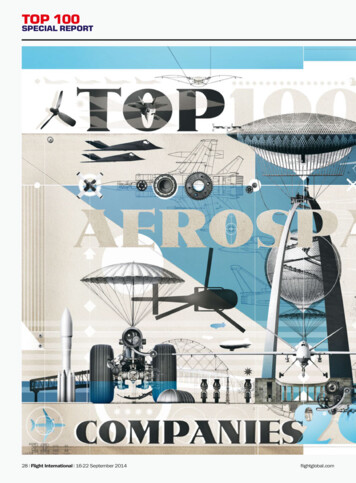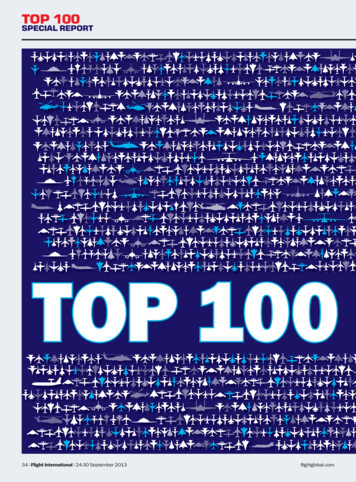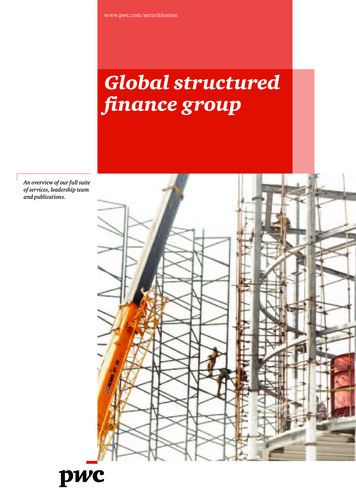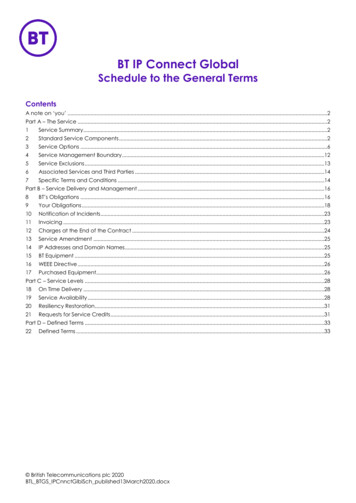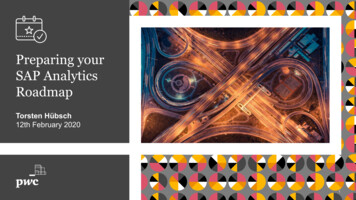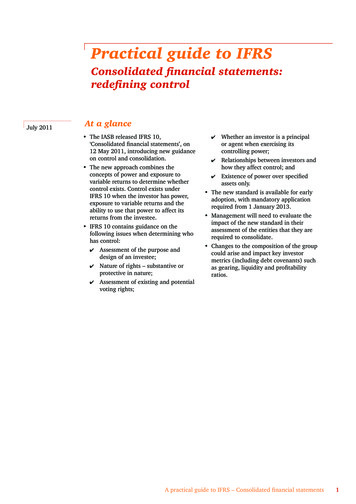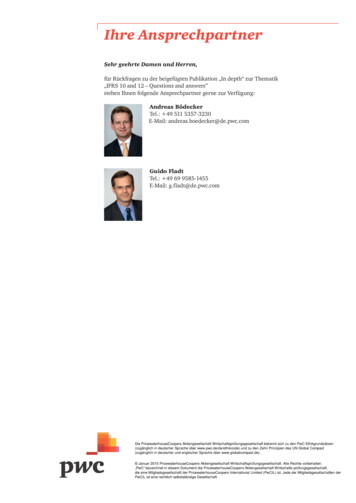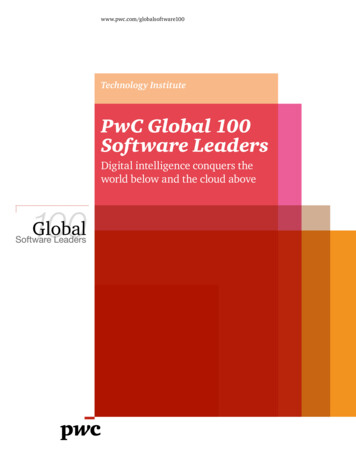
Transcription
www.pwc.com/globalsoftware100Technology InstitutePwC Global 100Software LeadersDigital intelligence conquers theworld below and the cloud above
Executive summaryThe new PwC Global 100 Software Leaders ranking reveals whois taking advantage of both the evolutionary and revolutionarychanges afoot in technology. While the cloud continues to underpinmassive change, other trends are building on its capabilities tocreate opportunities in digital innovation, industrial capabilities andconvergence within vertical markets. This initial article providesan overview of the trends impacting the global leaders and others.Future articles will examine issues impacting the fastest growingcloud-based companies and the larger software companies inemerging markets.2PwC Global 100 Software Leaders
IntroductionWe are in an era of innovationthat seems to have no precedent.Concurrent advances in softwaredevelopment, mobility, connectivityand analytics have combined tocreate a landscape in which ideasarise, and flourish quickly. Theunderlying foundation to thisinnovation is software—smarter,leaner and better software.The new edition of the PwC Global100 Software Leaders rankingreveals the vendors who are takingadvantage of both the evolutionaryand revolutionary changes afootin technology. While the cloudcontinues to underpin massivechange, other trends are building onits capabilities to create opportunitiesin digital innovation, industrialcapabilities and convergence withinvertical markets.The spoils go to anyone whosecode represents an improvement.As a result, startup vendors arechallenging established softwarecompanies, sometimes withsignificantly better ideas. The PwCGlobal 100 Software Leaders listcontains examples of this. Cloudbased Workday, which appears on theGlobal 100 for the first time at #72,is challenging existing companies inthe human-resources space. Splunk, astartup focused on big-data analyticsdebuting at #100, is challengingestablished firms in similar areas.Customers are seeing rampantchanges as well. Enterprises havethe opportunity to take advantageof various new deployment options,not only from startups, but also fromestablished vendors. The spectrumof options encompasses everythingfrom private to public cloud, fromonsite to offsite hosting and fromperpetual licenses to month-tomonth subscriptions.Our research yields fourkey findings:The partnership landscape alsopercolates. Consider GeneralMotors partnering with Lyft forwhat might be driverless cars, orRoche partnering with Qualcommto improve remote monitoring ofpatients with chronic diseases. Forcompanies seeking to use software—either their own or someone else’s—for a competitive advantage, thechoices may be overwhelming. The move to SaaS significantlyimpacts the revenue of traditionalvendors. The software industry isexperiencing a rapid expansion ofits total addressable market (TAM)and a high level of turbulence. Cloud adoption is creating newsoftware-as-a-service (SaaS)-basedbusiness models. Connected devices and artificialintelligence (AI) are creating newbusiness opportunities.This is the fourth edition of PwC’sGlobal 100 Software Leaders rankingsince 2010. The current editioncontinues our tradition of monitoringand analysing the leading companiesand trends in the industry. Our goalis to help our clients understand boththe obvious and the underlying forcesinfluencing the software industry.Thanks to software, we arenot only living in a time ofunprecedented innovation,but also one of unprecedentedopportunity and uncertainty.PwC3
Global 100 Software LeadersAnalysing the changes between the current Global 100 Software Leaders andthe previous ranking, published in 2014, indicates just how dynamic the marketis. Both lists were compiled for PwC by International Data Corp. (IDC). (Formore information on how the lists are compiled, see the Methodology sectionon page 20.) Fourteen companies fell off the current list, which means 14are new. A churn of 28 seems like quite a bit in just two years. Four of the 14companies that fell off the list were acquired, and one (Compuware) split intotwo companies. Actually, it’s fairly easy to fall off the list. Of the bottom 12 inthe previous list, 10 are gone.Growth and innovation continue apaceThe Global 100 Software Leaders' revenues grew from US 247.5 billion in2012 to US 272.2 billion in 2014, a 10% increase. Meanwhile, the rest of theindustry grew 13% amidst a relatively weak global economy.(US Billion)Growth rate 400 300 200 113.1B 100.1B 86.0B 100.5B 161.5B 171.7B13%16.9% 10006.3%2012Top 10 software companies2014#11-100Rest of the software industrySource: PwC's Global 100 Software Leaders report with data provided by IDC.4PwC Global 100 Software Leaders
“Several companies couldn’t keepup their growth and as a result felloff the list,” says Mark McCaffrey,PwC Global Software Leader, “Thereare others that are large enough tosurvive because they have the cashand the wherewithal to acquirecloud companies.”Many companies show staying power:Microsoft remains at #1, while Oracleand IBM have swapped as #2 and #3,with Oracle edging out IBM. Othercompanies in the top 20 from theprevious list have moved up: Symantec, up one position to #5; EMC, up two at #6; Salesforce, up four to #9 Intuit, up six to #10.A couple of big jumps are worthmentioning: Google leaped from #52to #20, while Dell jumped from #64to #36. (See table on pages 6-9)“Many factors affect downwardmovement,” says Raman Chitkara,PwC Global Technology Leader.“These include the ongoing shiftfrom a licensing to a SaaS businessmodel, competition from startupsand the challenge of digitisation. Insome cases, a lack of agility when itcomes to executing organisationalchange could be the issue.”Some companies are clearly takingadvantage of the SaaS revolution. Thecurrent Global 100 Software Leadersalso ranks SaaS and platform-as-aservice (PaaS) revenue for the top50 companies, and the percentageeach segment comprises of overallsoftware revenue. The companieswith the biggest jump in the combinedpercentage represent a small groupthat is on the cutting edge.Among the top 20 companies the listof SaaS standouts includes: Intuit (#10) with 46% of revenuesfrom SaaS;Moving in the other direction in thetop 20: Adobe (#11) with 23% of revenues; HP, down one position at #8; Cisco Systems (#14) with 35%; CA Technologies, down two at #12; Citrix (#19) with 27%. Adobe, down two at #11.These are indications of companies thatunderstand the changes underway.(See table on pages 12-13)Somecompanies areclearly takingadvantageof the SaaSrevolution.PwC5
Global 100Rank CompanyCountryHQ2014 Softwarerevenue(US M)2014 Totalrevenue(US M)Softwarerevenue as% of total1MicrosoftUSA 62,014 93,45666.4%2OracleUSA 29,881 38,82877.0%3IBMUSA 29,286 92,79331.6%4SAPGermany 18,777 23,28980.6%5SymantecUSA 6,138 6,61592.8%6EMCUSA 5,844 24,43923.9%7VMwareUSA 5,520 6,03591.5%8Hewlett PackardUSA 5,082 110,5774.6%9Salesforce.comUSA 4,820 5,27491.4%10IntuitUSA 4,324 4,57394.6%11AdobeUSA 4,061 4,183.597.1%12CA TechnologiesUSA 4,053 4,41091.9%13SAS*USA 2,884 3,08493.5%14Cisco SystemsUSA 2,836 47,8235.9%15Dassault SystèmesFrance 2,695 3,03888.7%16SiemensGermany 2,613 95,5422.7%17FujitsuJapan 2,527 43,5265.8%18AutodeskUSA 2,413 2,48697.1%19CitrixUSA 2,376 3,14375.6%20GoogleUSA 2,273 66,0013.4%21HitachiJapan 2,159 91,2462.4%22AppleUSA 2,110 199,8001.1%23InforUSA 2,099 2,81574.6%24SynopsysUSA 1,934 2,10092.1%25IntelUSA 1,899 55,8703.4%*Denotes a privately held company6PwC Global 100 Software Leaders
Rank CompanyCountryHQ2014 Softwarerevenue(US M)2014 Totalrevenue(US M)Softwarerevenue as% of total26BMCUSA 1,878 2,08790.0%27SageUK 1,724 1,76297.8%28ADPUSA 1,660 10,60415.7%29Wolters KluwerThe Netherlands 1,539 4,88031.5%30Red HatUSA 1,517 1,74187.1%31OpenTextCanada 1,496 1,85880.5%32SunGard*USA 1,464 2,80852.1%33NECJapan 1,441 28,1515.1%34Cadence Design SystemsUSA 1,435 1,57990.9%35HexagonUK 1,413 3,49740.4%36DellUSA 1,395 58,5002.4%37TeradataUSA 1,221 2,73244.7%38NetAppUSA 1,169 6,25218.7%39NCRUSA 1,157 6,59117.6%40Epic Systems*USA 1,140 1,77064.4%41Constellation SoftwareCanada 1,134 1,23092.2%42McKessonUSA 1,123 168,7110.7%43Mentor GraphicsUSA 1,076 1,23187.4%44PTCUSA 1,073 1,35879.1%45Trend MicroJapan 1,035 1,09095.0%46Nuance CommunicationsUSA 1,009 1,92752.3%47DATEV*Germany 975 1,11987.1%48Esri*USA 960 1,12985.0%49CernerUSA 946 3,40227.8%50ANSYSUSA 917 93698.0%*Denotes a privately held companyPwC7
Rank CompanyCountryHQ2014 Softwarerevenue(US M)2014 Totalrevenue(US M)Softwarerevenue as% of total51InformaticaUSA 914 1,04887.2%52TIBCO*USA 847 1,01683.4%53Software AGGermany 843 1,13874.1%54Optum*USA 819 47,7461.7%55Schneider ElectricFrance 804 33,2522.4%56FiservUSA 781 5,06615.4%57AvayaUSA 766 4,31917.7%58Kronos*USA 762 1,05472.3%59The Attachmate Group*USA 733 87284.1%60GE HealthcareUK 732 18,3004.0%61Epicor SoftwareUSA 731 99473.5%62Verint SystemsUSA 725 1,11065.3%63Concur TechnologiesUSA 724 73299.0%64athenahealthUSA 711 75394.5%65Kaspersky Lab*Russia 695 71197.7%66Wincor NixdorfGermany 666 3,27920.3%67FICOUSA 643 79481.0%68FISUSA 633 6,4009.9%69Misys*UK 611 89668.2%70JDA Software*USA 605 1,00960.0%71SWIFTBelgium 602 79276.0%72WorkdayUSA 592 76077.9%73Genesys TelecommunicationsLaboratories*USA 587 85069.0%74TOTVSBrazil 584 75277.7%75NICE SYSTEMSIsrael 576 1,01256.9%*Denotes a privately held company8PwC Global 100 Software Leaders
Rank CompanyCountryHQ2014 Softwarerevenue(US M)2014 Totalrevenue(US M)Softwarerevenue as% of total76ServiceNowUSA 569 68383.4%77CommVaultUSA 565 61492.0%78Bentley Systems*USA 532 62585.1%79ConvergysUSA 528 2,85618.5%80NeusoftChina 508 1,26940.0%81VismaNorway 507 1,12944.9%82QlikUSA 503 503100.0%83Micro FocusUK 502 51996.7%84ACI WorldwideUSA 489 1,01648.2%85InterSystems*USA 489 489100.0%86Palantir*USA 484 56985.0%87Unit4The Netherlands 480 69668.9%88AllscriptsUSA 477 1,37734.6%89MEDITECHUSA 476 51792.0%90Blackboard*USA 467 66070.7%91Amazon.comUSA 466 88,9880.5%92Micros SystemsUSA 464 90451.3%93PegasystemsUSA 449 59076.1%94NetSuiteUSA 449 55680.6%95MicroStrategyUSA 447 58077.1%96ESET*Slovakia 437 48690.0%97Pitney BowesUSA 430 3,82211.2%98SolarWindsUSA 428 428100.0%99Ultimate SoftwareUSA 420 50683.0%100SplunkUSA 404 43592.9%*Denotes a privately held companyPwC9
Evolution vs. revolutionAs we look to the future, PwC seesan industry experiencing a high levelof turbulence. On the one hand, wesee a lot of evolution. The trends weidentified in previous analyses ofthe software industry continue. Thecloud, in the form of SaaS, PaaS orinfrastructure-as-a-service (IaaS),is becoming increasingly popular asenterprises recognise the flexibilityit brings to applications and otherdeployments. Its adoption is creatingnew SaaS-based business models.Subscription-based deploymentsare increasingly replacing softwarelicensing, which significantlyimpacts the revenue streams oftraditional vendors. Amy Konary,IDC Programme Vice President forSaaS, Business Models and MobileEnterprise Apps, deems 2016 an“inflection point” in the relationshipbetween software subscriptionsand licenses. According to IDCcalculations, subscriptions will grow20% and licensing will decrease1.7% in 2016. One only has to look atAdobe’s 2013 change in strategy—moving from licensing to subscriptionsales—for an example of a companymaking the difficult shift.10PwC Global 100 Software LeadersSoftware industry concentrationThe top 10 global software companies generated almost half of the entireindustry's revenues. The top 5 lag in cloud-based revenues.2014 revenuesOverall softwareindustry revenuesTop 100 revenuesTop 10 softwarecompaniesTop 5 softwarecompaniesTotal SaaS/PaaSrevenues of top 50companiesTop 10 shareof SaaS/PaaSrevenuesTop 5 shareof SaaS/PaaSrevenuesUS 385.3BUS 272.2BUS 171.7BUS 146.1BUS 22.4B% of total71%45%38%% of top 50PaaS/SaaSrevenuesUS 14.0B63%US 6.5B29%Source: PwC's Global 100 Software Leaders report with data provided by IDC.
The ubiquity of anytime, anywheremobile access continues to demandhigher system availability andreliability, and the resulting need forwireless connectivity underscoresongoing concerns about security.There is also a revolution underwayin software, characterised by the ideaof convergence. This creates newbusiness model opportunities. Withdigital technology infusing so manyindustries and launching so manyinnovations, we’re seeing the dawnof what we call ‘software & [fill inthe industry].’ In whatever industrycompanies participate there is anoverwhelming presence of intelligentsoftware. Companies like Boeingand General Electric (GE) beg thequestion: what defines a softwarecompany? (See the sidebar, “Theindustrial software dilemma” onpage 18)Think about it: everywhere you look,software is defining what products do,and thus redefining what categoriescompanies fall into. SchneiderElectric (#55) specialises in electricitydistribution, but it also has launchedinitiatives in automation and energymanagement. Two companies not onthe list, exercise-device company Fitbitand sports-camera company GoPro,manufacture hardware devices, buttheir devices rely heavily on softwareto track usage or disseminate video.GE manufactures everything fromjet engines and power equipment tomedical devices, and is increasinglyinfusing those devices withsoftware not only to gather post-saleinformation but also to extend therelationship with customers throughservice agreements.The revolution is especially invasivein new kinds of software companies.Is Uber a software company ora transportation company? It ismore accurate to think of it as aride-sharing platform. Its softwareprovides value to customers whoneed to track expenses and valueto Uber itself in setting costs andmonitoring drivers. AirBnB is the firstlarge-scale, high-value hospitalitycompany that has no physicalinventory. Does that make it a lodgingcompany or a software company?It is more precise to think of it as alodging-lodger matching platform.Within this changing landscape,we have identified three basic andinterwoven trends: Digital innovation: Startupsand legacy companies alikeare competing to provide newcapabilities, fueled by low interestrates and globalisation. Industry 4.0: Together thesoftware-based cloud andhardware-based Internet of Things(IoT) are rewriting the rules ofwhat can be done, and how quicklyit can be done. Convergence: New softwarecapabilities are triggeringwholesale transformation ofevery vertical industry.PwC11
SaaS revenues of Top 50 software companiesCountryHQ2014Softwarerevenue(US M)2014 Totalrevenue(US M)2014SaaS PaaSrevenue†SaaS PaaS% ofsoftwareSaaS % ofSaaS PaaSPaaS % ofSaaS PaaS1MicrosoftUSA 62,014 93,456 2,2924%69%31%2OracleUSA 29,881 38,828 1,3274%98%2%3IBMUSA 29,286 92,793 1,0674%81%19%4SAPGermany 18,777 23,289 1,4298%98%2%5SymantecUSA 6,138 6,615 4187%100%0%6EMCUSA 5,844 24,439 2184%98%2%7VMwareUSA 5,520 6,035 641%95%5%8Hewlett PackardUSA 5,082 110,577 4088%80%20%9Salesforce.comUSA 4,820 5,274 4,820100%86%14%10IntuitUSA 4,324 4,573 1,98046%97%3%11AdobeUSA 4,061 4,184 91623%100%0%12CA TechnologiesUSA 4,053 4,410 1023%100%0%13SAS*USA 2,884 3,084 442%30%70%14Cisco SystemsUSA 2,836 47,823 1,00435%100%0%15Dassault SystèmesFrance 2,695 3,038 783%100%0%16SiemensGermany 2,613 95,542 783%100%0%17FujitsuJapan 2,527 43,526 291%100%0%18AutodeskUSA 2,413 2,486 452%100%0%19CitrixUSA 2,376 3,143 65227%100%0%20GoogleUSA 2,273 66,001 1,93185%82%18%21HitachiJapan 2,159 91,246 40%100%0%22AppleUSA 2,110 199,800 1517%100%0%23InforUSA 2,099 2,815 1005%99%1%24SynopsysUSA 1,934 2,100 00%0%0%25IntelUSA 1,899 55,870 28015%100%0%RankCompany*Denotes a privately held company†See page 20 for definitions of SaaS and PaaS revenues12PwC Global 100 Software Leaders
RankCompanyCountryHQ2014Softwarerevenue(US M)2014 Totalrevenue(US M)2014SaaS PaaSrevenue†SaaS PaaS% ofsoftwareSaaS % ofSaaS PaaSPaaS % ofSaaS PaaS26BMCUSA 1,878 2,087 774%100%0%27SageUK 1,724 1,762 201%100%0%28ADPUSA 1,660 10,604 1,54793%100%0%29Wolters KluwerTheNetherlands 1,539 4,880 1248%100%0%30Red HatUSA 1,517 1,741 10%0%100%31OpenTextCanada 1,496 1,858 26818%0%100%32SunGard*USA 1,464 2,808 60%100%0%33NECJapan 1,441 28,151 131%100%0%34Cadence DesignSystemsUSA 1,435 1,579 00%0%0%35HexagonUK 1,413 3,497 00%0%0%36DellUSA 1,395 58,500 121%100%0%37TeradataUSA 1,221 2,732 161%47%53%38NetAppUSA 1,169 6,252 00%0%0%39NCRUSA 1,157 6,591 49243%100%0%40Epic Systems*USA 1,140 1,770 00%0%0%41Constellation SoftwareCanada 1,134 1,230 222%100%0%42McKessonUSA 1,123 168,711 00%0%0%43Mentor GraphicsUSA 1,076 1,231 00%0%0%44PTCUSA 1,073 1,358 00%0%0%45Trend MicroJapan 1,035 1,090 798%100%0%46NuanceCommunicationsUSA 1,009 1,927 00%0%0%47DATEV*Germany 975 1,119 00%0%0%48Esri*USA 960 1,129 313%100%0%49CernerUSA 946 3,402 25827%100%0%50ANSYSUSA 917 936 273%100%0%*Denotes a privately held company†See page 20 for definitions of SaaS and PaaS revenuesPwC13
Key trend #1: Digital innovationNo matter how much the Global100 churned, the companies on thelist face a changing environment.Consider the startup landscape: notonly are there a lot of new startupsthey also represent new levels ofdynamic creativity.Why are there more startups? Part ofthe answer comes from the unsettledeconomy. Thanks to equity marketjitters, the rate of IPOs is slowingdown. Thanks to low interest rates,private equity firms and hedge fundsare looking for new options for capitalinvestment, and startups represent aviable path. Nor does the pace seemto be slowing: the city of Paris isspending 200 million on a startupincubator that it hopes will attract asmany as 1,000 entrepreneurs fromaround the world.1These startups are taking advantageof the new world of technologyto come up with ideas. Besidesapplications that take advantage of thesharing economy, like Uber, Lyft andAirBnB, the market is being floodedwith everything from digital paymentservices to health care companiespromoting in-home services.1 ailway-yard14PwC Global 100 Software LeadersThanks to expandingindustrialisation, innovation canhappen anywhere. Thanks tomobility and the cloud, softwarecan be consumed anywhere. Butglobalisation is a two-edged swordwhen it comes to innovation.Government regulations, such as theEuropean Union’s Safe Harbour rulesgoverning data privacy, still createobstacles. For instance, its initialrules slowed the region’s adoptionof SaaS applications, and confusionreigns over the implementation ofupdated rules.Furthermore, in this burgeoning worldof innovation, regional companies inemerging markets also face conflictingconditions. On the one hand, theyhave an advantage in that they canlaunch an application addressinga local market need and conformto local regulations. Once they gettraction, they can use that success tofend off competition. On the otherhand, they have a disadvantage inachieving scalability when it comestime to compete against companiesthat have launched from largermarkets like the US.Startups face another competitivechallenge. Established softwarecompanies aren’t standing still when itcomes to offering cloud-based optionsto customers. The top four companieson the list all made recent significantcloud acquisitions, from Oracle buyingResponsys for its cross-channelmarketing software to SAP buyingConcur Technologies (#63) for itsexpense-management software.If necessary, they’re setting up techbased subsidiaries to attract newcustomers and to ease the transitionfrom legacy systems. Barry Jaber, apartner in Strategy Consulting at PwC,notes that this tactic gives establishedcompanies a buffer during thetransition: “You’re not over-exposingto legacy systems while you migrateonto the new platform.”Thanks toexpandingindustrialisation,innovation canhappen anywhere.
North American software companies increaseindustry share of top 100NA and EMEA software companies grew at 11.8% and 7.8%, respectively, while APACcompanies lo
companies seeking to use software— either their own or someone else’s— for a competitive advantage, the choices may be overwhelming. This is the fourth edition of PwC’s Global 100 Software Leaders ranking since 2010. The current edition continues our tradition of monitoring and an
